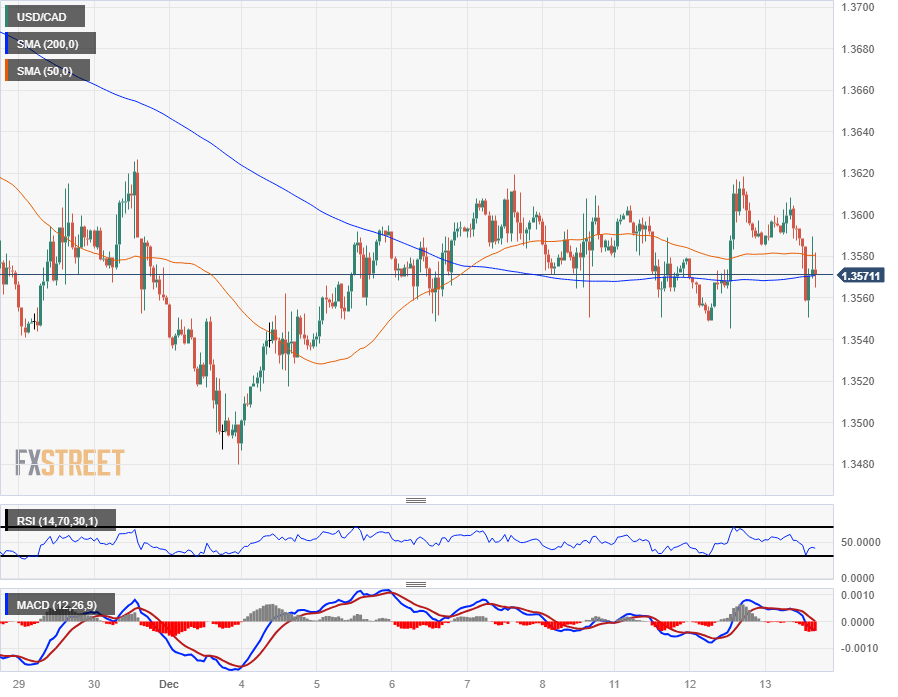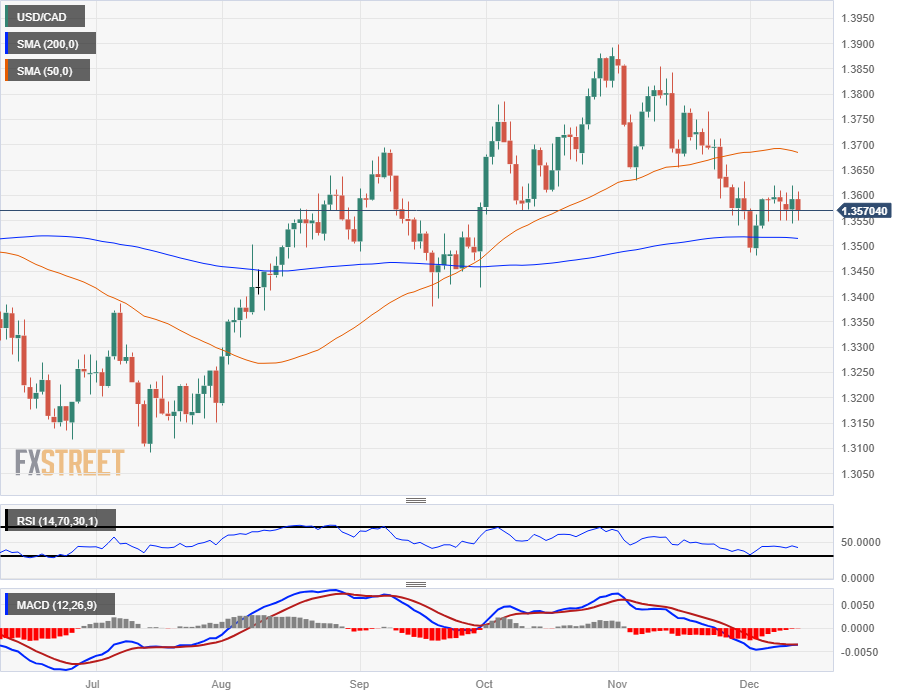- Phân tích
- Tin tức và các công cụ
- Tin tức thị trường
- Canadian Dollar churns as markets gear up for last US Fed rate call of 2023
Canadian Dollar churns as markets gear up for last US Fed rate call of 2023
- Canadian Dollar is set for a bumpy ride as markets face down one last appearance from Fed Chair Powell.
- FOMC updates Dot Plot as investors hope for a firm path toward rate cuts in 2024.
- CAD catches a supporting bid from rising Crude Oil, WTI bounces from new lows.
The Canadian Dollar (CAD) is moderately bid on Wednesday, gaining support from a thin but noticeable relief rally in Crude Oil markets. Still, markets see plenty of chop as investors jockey for position ahead of the US Federal Reserve’s (Fed) last appearance for 2023.
The Canadian economic calendar remains tepid this week; Loonie traders will be forced to wait until Bank of Canada (BoC) Governor Tiff Macklem’s appearance late Friday before the CAD finds tradeable headlines from behind home plate.
Markets are keenly waiting the Fed’s Federal Open Market Committee (FOMC) meeting to deliver their updated Interest Rate Outlook, known as the “Dot Plot”. With the Fed all but guaranteed to hold rates at 5.5% for their last rate decision of 2023, investors will be diving into the FOMC’s rate expectations as well as the Fed’s stance moving forward.
The Fed’s Monetary Policy Statement and Interest Rate Projections will be released at 14:00 EST(19:00 GMT). Fed Chairman Jerome Powell’s last press conference of the year is slated to begin at 14:30 EST (19:30 GMT).
Daily Digest Market Movers: Canadian Dollar grinds through frothy markets ahead of Fed rate call
- Despite the Canadian Dollar’s Crude Oil-fueled bid on Wednesday, the Fed is stealing the limelight, and it’s all eyes on Powell for the mid-week market session.
- The Federal Reserve is set to hold rates at 5.5% for the third straight FOMC meeting, its longest holding pattern since the most recent rate hike cycle began in early 2022.
- Investors are broadly anticipating an accelerated path toward more frequent rate cuts next year.
- Markets are anticipating rate cuts to begin as soon as the first quarter of 2024, and investor expectations of easing rates may have run well ahead of what the Fed considers achievable.
- With Fed Chair Powell scrapping forward guidance last year, Fed rate statements have an outsized market impact as the US central bank assesses data on a case-by-case basis.
- Crude Oil markets sank to fresh lows this week, with West Texas Intermediate (WTI) sagging into $68 per barrel early Wednesday before catching a near-term relief rally back toward $70.
- The Canadian Dollar is latching onto the rebound in Crude Oil to squeeze out a tenth of a percent gain against the US Dollar (USD) heading into the Fed release window.
Canadian Dollar price this week
The table below shows the percentage change of Canadian Dollar (CAD) against listed major currencies this week. Canadian Dollar was the strongest against the Pound Sterling.
| USD | EUR | GBP | CAD | AUD | JPY | NZD | CHF | |
| USD | -0.20% | 0.18% | -0.12% | 0.00% | 0.15% | 0.05% | -0.37% | |
| EUR | 0.22% | 0.40% | 0.10% | 0.26% | 0.37% | 0.28% | -0.14% | |
| GBP | -0.19% | -0.41% | -0.30% | -0.17% | -0.03% | -0.15% | -0.56% | |
| CAD | 0.12% | -0.08% | 0.29% | 0.12% | 0.27% | 0.17% | -0.25% | |
| AUD | -0.01% | -0.22% | 0.18% | -0.12% | 0.15% | 0.05% | -0.38% | |
| JPY | -0.16% | -0.39% | -0.09% | -0.28% | -0.17% | -0.12% | -0.55% | |
| NZD | -0.05% | -0.25% | 0.13% | -0.17% | -0.05% | 0.10% | -0.42% | |
| CHF | 0.37% | 0.17% | 0.54% | 0.25% | 0.41% | 0.53% | 0.43% |
The heat map shows percentage changes of major currencies against each other. The base currency is picked from the left column, while the quote currency is picked from the top row. For example, if you pick the Euro from the left column and move along the horizontal line to the Japanese Yen, the percentage change displayed in the box will represent EUR (base)/JPY (quote).
Technical Analysis: Canadian Dollar’s sideways stance set to get rattled, USD/CAD in play near 1.3600
The Canadian Dollar (CAD) sees choppy trading forming into a near-term sideways channel against the US Dollar (USD), keeping the USD/CAD capped between 1.3610 and 1.3550. Intraday action remains chained to the 200-hour Simple Moving Average (SMA) as near-term momentum drains out of the pair.
A bounce from the 200-day SMA for the USD/CAD at the start of December has failed to crystallize into a meaningful bullish recovery, keeping the pair constrained in a congestion zone just beneath the 1.3600 handle.
The US Dollar is down two-and-a-third percent against the Canadian Dollar after dropping from December’s early high of 1.3899 and making a clean shear of the 50-day SMA just below 1.3700.
Fundamentals are going to drive the USD/CAD on Wednesday, and technical traders will need to be mindful that technical barriers could easily evaporate, depending on how investors digest the day’s headlines.
USD/CAD Hourly Chart

USD/CAD Daily Chart

Canadian Dollar FAQs
What key factors drive the Canadian Dollar?
The key factors driving the Canadian Dollar (CAD) are the level of interest rates set by the Bank of Canada (BoC), the price of Oil, Canada’s largest export, the health of its economy, inflation and the Trade Balance, which is the difference between the value of Canada’s exports versus its imports. Other factors include market sentiment – whether investors are taking on more risky assets (risk-on) or seeking safe-havens (risk-off) – with risk-on being CAD-positive. As its largest trading partner, the health of the US economy is also a key factor influencing the Canadian Dollar.
How do the decisions of the Bank of Canada impact the Canadian Dollar?
The Bank of Canada (BoC) has a significant influence on the Canadian Dollar by setting the level of interest rates that banks can lend to one another. This influences the level of interest rates for everyone. The main goal of the BoC is to maintain inflation at 1-3% by adjusting interest rates up or down. Relatively higher interest rates tend to be positive for the CAD. The Bank of Canada can also use quantitative easing and tightening to influence credit conditions, with the former CAD-negative and the latter CAD-positive.
How does the price of Oil impact the Canadian Dollar?
The price of Oil is a key factor impacting the value of the Canadian Dollar. Petroleum is Canada’s biggest export, so Oil price tends to have an immediate impact on the CAD value. Generally, if Oil price rises CAD also goes up, as aggregate demand for the currency increases. The opposite is the case if the price of Oil falls. Higher Oil prices also tend to result in a greater likelihood of a positive Trade Balance, which is also supportive of the CAD.
How does inflation data impact the value of the Canadian Dollar?
While inflation had always traditionally been thought of as a negative factor for a currency since it lowers the value of money, the opposite has actually been the case in modern times with the relaxation of cross-border capital controls. Higher inflation tends to lead central banks to put up interest rates which attracts more capital inflows from global investors seeking a lucrative place to keep their money. This increases demand for the local currency, which in Canada’s case is the Canadian Dollar.
How does economic data influence the value of the Canadian Dollar?
Macroeconomic data releases gauge the health of the economy and can have an impact on the Canadian Dollar. Indicators such as GDP, Manufacturing and Services PMIs, employment, and consumer sentiment surveys can all influence the direction of the CAD. A strong economy is good for the Canadian Dollar. Not only does it attract more foreign investment but it may encourage the Bank of Canada to put up interest rates, leading to a stronger currency. If economic data is weak, however, the CAD is likely to fall.
© 2000-2024. Bản quyền Teletrade.
Trang web này được quản lý bởi Teletrade D.J. LLC 2351 LLC 2022 (Euro House, Richmond Hill Road, Kingstown, VC0100, St. Vincent and the Grenadines).
Thông tin trên trang web không phải là cơ sở để đưa ra quyết định đầu tư và chỉ được cung cấp cho mục đích làm quen.
Giao dịch trên thị trường tài chính (đặc biệt là giao dịch sử dụng các công cụ biên) mở ra những cơ hội lớn và tạo điều kiện cho các nhà đầu tư sẵn sàng mạo hiểm để thu lợi nhuận, tuy nhiên nó mang trong mình nguy cơ rủi ro khá cao. Chính vì vậy trước khi tiến hành giao dịch cần phải xem xét mọi mặt vấn đề chấp nhận tiến hành giao dịch cụ thể xét theo quan điểm của nguồn lực tài chính sẵn có và mức độ am hiểu thị trường tài chính.
Sử dụng thông tin: sử dụng toàn bộ hay riêng biệt các dữ liệu trên trang web của công ty TeleTrade như một nguồn cung cấp thông tin nhất định. Việc sử dụng tư liệu từ trang web cần kèm theo liên kết đến trang teletrade.vn. Việc tự động thu thập số liệu cũng như thông tin từ trang web TeleTrade đều không được phép.
Xin vui lòng liên hệ với pr@teletrade.global nếu có câu hỏi.















